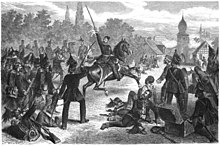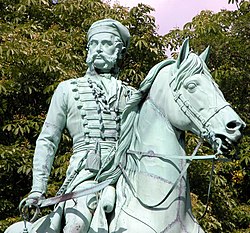
Back الفوج الأسود Arabic Schwarze Schar German Schwarze Schar French לגיון דוכס בראונשווייג HE Schwarze Schar ID Schwarze Schar Italian 黒い軍勢 Japanese 슈바르체 샤르 Korean Czarny Korpus Polish Чёрные брауншвейгцы Russian
| Herzoglich Braunschweigisches Feldcorps | |
|---|---|
 The Brunswick Ducal Corps at the Battle of Halberstadt led by the Black Duke | |
| Active | 1809-1820s |
| Nickname(s) | Schwarze Schar (Black Troop/Horde/Host) Schwarze Legion (Black Legion) Black Brunswickers |
| Motto(s) | Sieg oder Tod! (Victory or Death!) |
| March | Marsch Herzog von Braunschweig |
| Engagements | Battle of Halberstadt Battle of Olper Battle of Quatre Bras Battle of Waterloo |

The Brunswick Ducal Field-Corps (German: Herzoglich Braunschweigisches Feldcorps), commonly known as the Black Brunswickers in English and the Schwarze Schar (Black Troop, Black Horde, or Black Host) or Schwarze Legion (Black Legion) in German, were a military unit in the Napoleonic Wars. The corps was raised from volunteers by German-born Frederick William, Duke of Brunswick-Wolfenbüttel (1771–1815). The Duke was a harsh opponent of Napoleon Bonaparte's occupation of his native Germany.[1] Formed in 1809 when war broke out between the First French Empire and the Austrian Empire, the corps initially comprised a mixed force, around 2,300 strong, of infantry, cavalry and later supporting artillery.[1][2][3]
Most units of the corps wore black uniforms, leading to the "black" nicknames of the unit, though some light units (such as sharpshooters and uhlans) wore green uniforms. The Brunswickers wore silvered skull "totenkopf" badges on their hats. Their title originated from Duke Frederick William, who claimed the Duchy of Brunswick-Lüneburg, which the French had abolished in order to incorporate its lands into the French satellite Kingdom of Westphalia. The Black Brunswickers earned themselves a fearsome reputation over the following decade, taking part in several significant battles including the prelude to the Battle of Waterloo, at Quatre Bras on 16 June 1815, where the Duke lost his life. However, recruiting, the replacement of casualties, and finance had always been problematic, and the corps was disbanded in the early 1820s.
The exploits of the Brunswickers caught the British Victorian public's imagination: an example of this can be found in John Everett Millais's painting The Black Brunswicker. Completed in 1860, the painting depicts a Brunswicker in his black uniform bidding goodbye to an unnamed woman.
- ^ a b "Osprey Publishing". Archived from the original on 27 September 2007. Retrieved 7 April 2007.
- ^ "Lady Lever Art Gallery - artwork of the month". Retrieved 7 April 2007.
- ^ "Infoplease.com". Retrieved 7 April 2007.